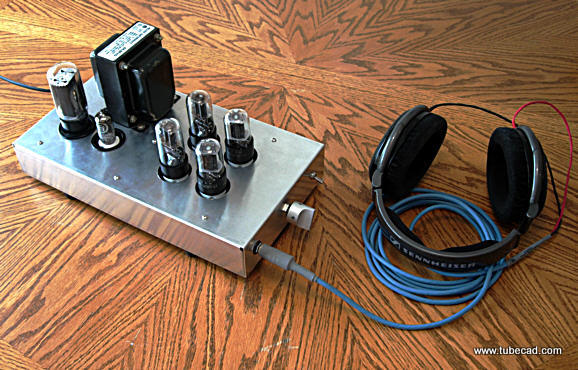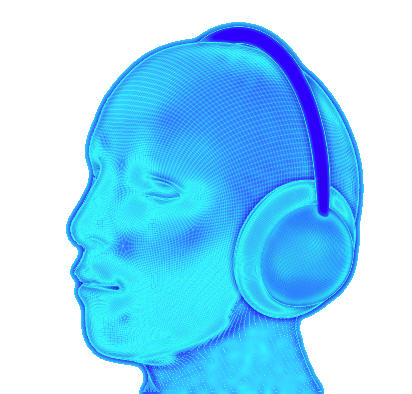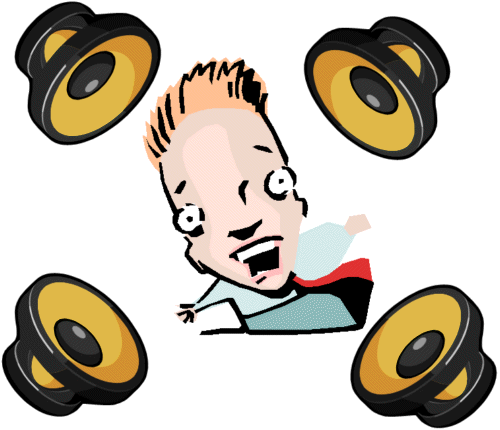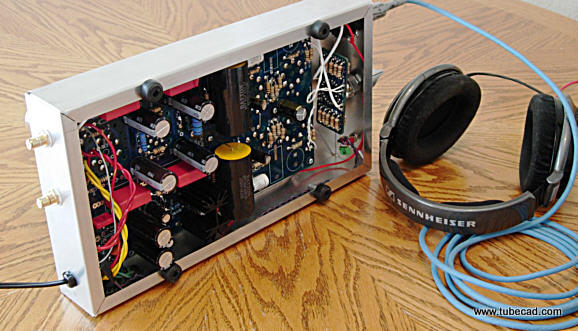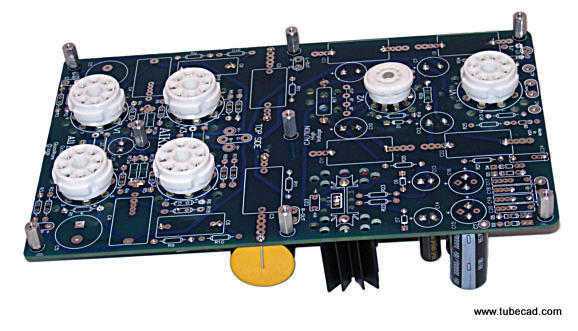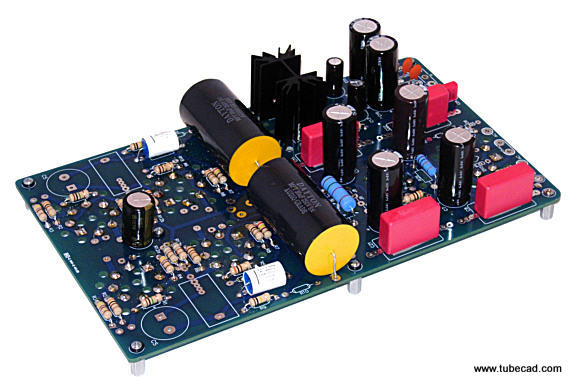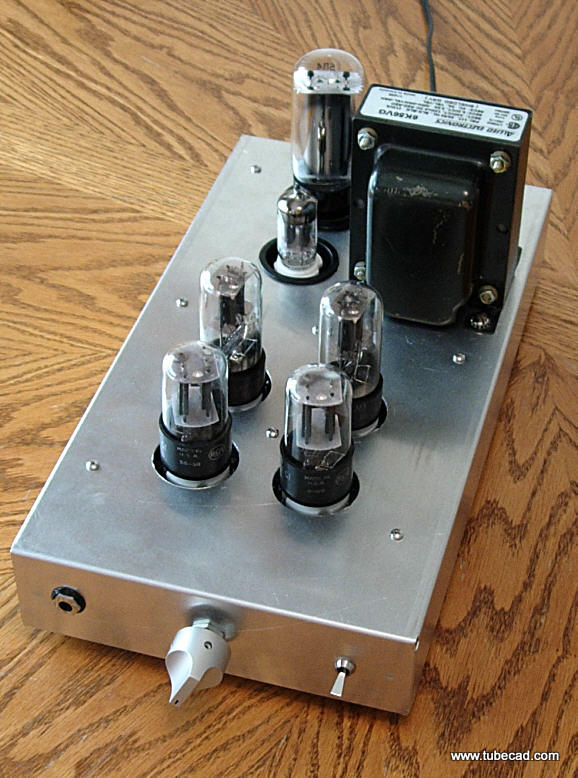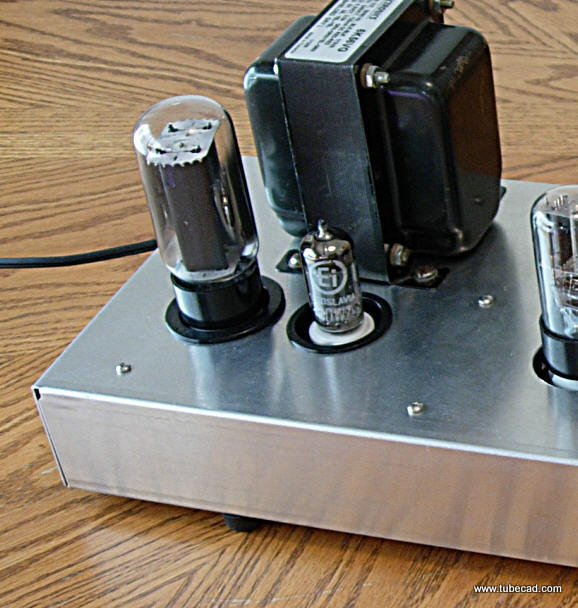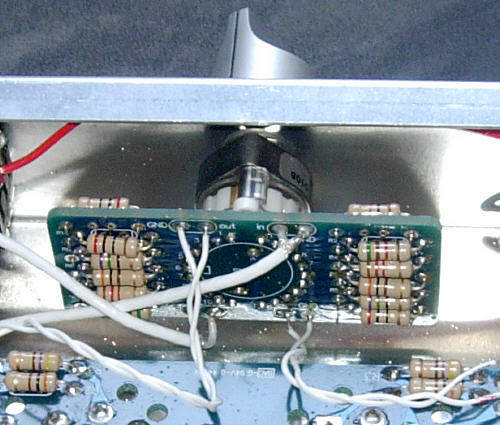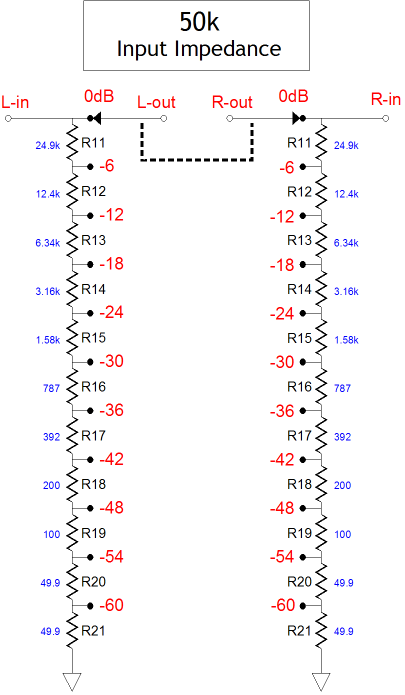| John Broskie's Guide to Tube Circuit Analysis & Design |
14 February 2010
Octal All-in-One LSA/HPA Before I can sell a new PCB design, I have to assemble and test it, so I decided to assemble the Octal All-in-One LSA/HPA using carbon-film resistors, which are also more retro. I started on it this past December, but my project was put on hold for weeks; last week I finally resumed and finished my project. Below is the result.
This is my newest headphone amplifier, bringing the total of headphone amps that I own up to at least six: three solid-state, one hybrid, and two pure-tube—eight if we include two ES-headphone amplifiers. (I designed and built all but one of these headphone amplifiers.) Thus, a safe bet would be that I like to listen to headphones, but not every audiophile shares my penchant. Many audiophiles complain of feeling too restricted, too constrained while wearing headphones for comfort. I cannot argue against such reaction nor would I want to try.
Psychology is more important to the listening experience than many audiophiles imagine. For example, change the color of the speaker’s grill cloth, and you change the perception of the speaker's tonal balance. Place a third loudspeaker in the middle of the stereo pair, but secretly leave it unattached and, with the mute loudspeaker in place, most audiophiles will revel in the improved imaging. Stick a price tag marked $2400.00 on a run of $30 speaker cable and listen to the ooh's and aah's from your friends—or attach a $30 tag to $2400 cables and listened to the ensuing crumbles and fault finding from the same listeners. With headphone listening, I have found that, in general, introverts tend to like headphones, while extroverts don’t; but then I do know of several outstanding exceptions. One of the reasons that quadraphonic systems never caught on was that many like having their music over there, there being someplace away from them at a safe distance; with surround sound, these audiophiles feel uncomfortably encircled, smothered, trapped by the four loudspeakers.
Beyond psychology, there is one hindrance with headphone listening that few recognize. I am sure that I have mentioned this before—after 11 years, I have mentioned a lot—one of the reasons that headphones are not more widely used is that they are usually attached to solid-state gear. Surely I cannot be too far from right in guessing that 99.9% of headphone listening public has never heard a tube headphone amplifier. I am often told by audiophiles that they do not like Stax electrostatic headphones, which always prompts me to ask, “Really? Which electrostatic tube headphone amplifier did you use?” The reply is always the same, “I didn't; I used the Stax step-up transformer and a solid-state power amplifier (or the Stax solid-state electrostatic headphone amplifier).” Headphones reveal. That’s what they do best. With high-quality headphones you can hear details in a recording that no loudspeaker can expose, no matter how elaborate or expensive (although Vandersteen's new Model 7 may prove me wrong). And even $20 headphones hold the staggeringly powerful advantage of not using a crossover. So if 99.9% of headphones are attached to solid-state amplifiers, what do they reveal? No doubt you see where I am heading: solid-state gear often sounds brittle and gritty, which headphones readily reveal. So when someone complains that they do not like listening to headphones, are they actually, although unknowingly, condemning solid-state amplification?
I have a very simple, but sonically accurate test for headphone amplifiers: how long can I listen to it. The longer, the better. A headphone amplifier that seems to win the best-sound contest in a headphone amplifier shootout may only prove listenable for 20 minutes (or much less). In a quick AB switching shootout of loudspeakers, it’s rare for the speaker with the brighter tweeter not to win. It’s much easier to hear commission than omission. Bright highs dazzle the ears—in the short term; then after the novelty wears out, the ears complain. What sounded dull in comparison now sounds neutral and natural. Or as I put it in blog 28, “In the short term, meretricious usually wins over meritorious.” Well, in my experience, tube headphone amplifiers, in spite of many failings such as increased noise and flabbier bass, always prove far more listenable to than their solid-state competitors, in spite of their vastly better specifications. Maybe I am wrong here, maybe the absolute-headphone-amplifier faction is right, maybe the better headphone amplifier is the one that sounds best in a quick shootout. But how would it be better to own a headphone amplifier—the "best" headphone amplifier—and never listen to it? In addition, I am convinced that some music is better suited to loudspeaker playback, while other music works best with headphone listening. I have slowly figured this out over the past decades. I often try to digest a new album by listening to it via my headphones first, which works much like chewing your food slowly and thoroughly, before swallowing. Or maybe a better metaphor would be that listening with headphones first is like reading the CliffsNotes first before actually reading the assigned book or watching a foreign movie with the subtitles on before seeing it with them off. In other words, the headphones give me sharper picture of what I will see later with my loudspeakers, so I will have an easier time filling in the missing sonic details that the loudspeakers lose along the way. If you do not believe that your brain fills in missing details, try this experiment: wear some headphones and listen to something you know extremely well, The Beatles or Beethoven, then have someone else behind your back slowly turn down the volume; once you can no longer hear the music, raise your hand. What often happens is that the music will finally be completely turned off, the amplifier switched off, the headphone plug pulled from its socket, but the hand does not rise. (Early on, audiologist discovered that pure tones and not music must be used in testing a patient’s hearing.) Well, I have found that sometimes I just don’t like a new music purchase, in spite of rave reviews. So it sits on my shelf. Then one day I play the album on the loudspeakers because I am moving too much to be anchored by the headphones or a friend wishes to hear the album. Surprise, surprise! I now love the music. But when I listen to it again on headphones, I still don’t care for it. Conversely, some music that I have loved on headphones doesn’t fare as well played back on loudspeakers. Certainly, not all music divides into these two polarized divisions. One theory I have is that some music tells a story that must be fully apprehended to be appreciated (think opera or the Great American Songbook or country or even rap music) and often this type of music suits headphone listening best. Other music holds no real semantic content, but paints a moving wall of sonic texture and color, which only loudspeakers can do effectively. In other words, I will always need both headphones and loudspeakers.
Construction Details
The tube sockets and standoffs are all that attaches to the top of the PCB. All the other parts attach to the bottom. (I used super-strong, outdoor double-sided foam tape to hold the large coupling capacitors in place and the heatsink is soldered to the PCB by two fat pins. The only tricky part was attaching the low-voltage heater regulator to the PCB, as it, like the tubes, is not reversable the way a resistor or a film capcitor can be, as it holds a fixed pinout scheme that cannot be mirrored. Thus, I had to attach the regulator on the "wrong" side of the heatsink, bending the leads into the pad hole on the other side of the heatsink.
The chassis is a simple aluminum Bud box, 2 x 7 x 13 inches big, which I had sitting around waiting for a project to come along. If I were to buy a new Bud box, I would buy one 3 inches tall, as the power supply capacitors and heatsink are quite tall. I believe that wider box might also be welcome, although everything did fit in the 7in provided. I have to admit, that in spite of only requiring six punched holes and the drilling of only a dozen small holes, the chassis was a huge pain to make. But then, I probably made a huge mistake when I decided not to use my drill press, relying on my hand drill instead. (I don't know how most solder slingers manage, as drilling and punching a chassis is such a huge pain; maybe someday I'll find a good sheet-metal shop and have some nice universal chassis made.)
Punched holes are not as pretty as precision-drilled holes, so I planned on using black plastic hole guards to tart up the enclosure and protect my fingers from the large hole’s sharp edges. Below is a close up of the plastic hole guards used with the Janus regulator portion of the chassis. I gave up on adding these guards to the four 12SX7 tubes, as I don’t own the right size Greenly punch and I lack the patience to enlarge the four holes by hand with a file.
11-Position Series Stepped Attenuator
This attenuator is not for everyone. My original thought was that it would be perfect for electronic crossovers, with -1dB decrements and where one of the crossover's two (or three) outputs must be attenuated (usually the high-pass output) to bring both loudspeaker drivers' SPL in line with each other; or for a fancy line-stage amplifier or mixer that uses two stepped attenuators, a fine attenuator at the input and a coarse attenuator at the output, after the coupling capacitor. Another use for the attenuator would be creating an 11-position balance control. Only twelve resistors and 10 jumper wires would be needed. One attenuator section must have its input and ground connections swapped and the switch would be centered at mid position, which would entail a -5dB insertion loss for both channels. As the knob is rotated, one channel would receive increments of +1dB more gain per step, while the other channel would see a constant input level.
How Does This 12SX7-Based Headphone Amplifier Sound? So once again, how does the headphone amplifier sound? The headphone amplifier sounds quite good: extremely civilized and smooth. The mids and highs are silken and quite sweet sounding. (I will have to try a WE274B rectifier of which I [sort of] own two.) The bass is more than a bit flabby, but not too bad; in fact, I know those who love a fat bass from their headphones. The Sennheiser HD650s like to see a low Zo, which the 12SX7 will not provide, even in the White CF configuration. This is the second 12SX7-based headphone amplifier I have built. The first used the standard Aikido cathode follower output stage and its bass was much looser, so I wanted to try the White cathode follower instead, hoping that the halved output impedance would help; it did, but there’s plenty of room for improvement. So far, I have gone at least two hours without my ears calling it quits. (My four-year old daughter listened to it for over an hour other day -- Stevie Ray Vaughn, Jack Johnson, Diana Krall, and various South American singers -- and she loved it. She asked me, "Daddy, how come you have so much great music?" Warms daddy's heart.) But I have to admit that I listen to much lower volume levels than most audiophiles and those who claim that since their ears ring at live rock concerts, they should ring at home when listening to CDs will be disappointed by the maximum SPL this headphone amplifier can deliver. I also own a pair of Beyer DT990 headphones, which are fantasticly comfortable and more exciting sounding than the HD650s, but less efficient, so they do not mate well with this headphone amplifier. Headphones with 32-ohm impedeances, such as those from Grado, will not work with this amplifier, unless a step-down audio transformer were used. I must also admit that the best sound I have heard with the HD650s is with EH Gold 6H30 tubes in a White-cathode-follower configuration and with RCA clear-top 6CG7s as input tubes in my 9-pin All-in-One LSA/HPA board. Still, the 12SX7 is a magical tube... Probably the best pairing would be a 12SX7 cascading into a 6H30pi, the octal version of the 6H30, but the power transformer will not support that much heater current. With the 6H30pi, the idle current could easily be doubled, which would allow for more headroom. (I have been listening to the Jupiter 1uF/600V coupling capacitors in my main Aikido line stage and they sound very good indeed. They are not truly neutral, but much like a good push-up bra, the results can be quite tantalizing: some instruments are brought forward, while others recede; and, at all times, the sound is buttery smooth and natural sounding. It might make an expensive, but excellent bypass cap across the Dayton 30uF/250V output capacitors.)
Octal All-in-One LSA/HPA as Line-Stage Amplifier If I were building a new line-stage amplifier with this PCB, I would forgo the cool-looking tubes protruding trough the chassis for the simpler arrangement of having all the parts sit on top of the PCB and placing the PCB in a much bigger enclosure. Thus, although I am quite happy with my 12SX7-based headphone amplifier and I will not cannibalize this headphone amplifier, I just have something of a hard time justifying the extra effort spent on building it (if I didn't already own so many headphone amplifiers...). I do not want to end with a down note; I just want to avoid leading the tube novice astray. I know that many first-time readers will find this page via Google and they will proclaim that such a tube headphone amplifier is just what they have longed for. (I do not have to worry about accomplished solder-slingers, as they can take care of themselves.) Remember, building such a beast is quite difficult, although the large PCB does eliminate most of the wiring headaches; and this beast's roar is subduded compared to most solid-state adn hybrid designs. In addition, this headphone amplifier is not a universal headphone amplifier that can drive anything placed in its way; instead, you must conform to its limitations. Yet before writing it off completely, read on...
Important Audio Postscript
I just rewired the the Octal All-in-One LSA/HPA PCB to accept 6.3V tubes, such as the 6SN7, in the output stage position and replaced two 12SX7s with two New Russian 6SN7s. Hot dang! I had low expectations, so I wasn't ready for the improvement wrought by the substitution. Mercy. Yes, the old setup was smooth as $200 port wine, but it was missing a tad of spice and zest. After a ten minute burn-in period, I started by listening to Joshua Redman's Back East album and I could not stop listening. Songs that I didn't think I liked, I now liked. I can now readily hear the delicate decay of notes and the bass has tightened nicely and cymbols sound much more real. In other words, more spice and more zest. I am not sure if eliminating the RCA 12SX7s made the big difference or if the new Tungsols 6SN7s should get the lion share of credit, but the results are now in line with my expectations. Now, I have to undergo the prolonged headphone listening duration test, but I am finding this new sound extremely promising and I am eager to dig through favorite albums with this headphone amplifier lighting the way. The Octal All-in-One LSA/HPA is now available at the GlassWare Yahoo store. PCBs and partial kits are offered.
Next Time
//JRB |
E-mail from GlassWare Customers
High-quality, double-sided, extra thick, 2-oz traces, plated-through holes, dual sets of resistor pads and pads for two coupling capacitors. Stereo and mono, octal and 9-pin printed circuit boards available. Aikido PCBs for as little as $24 http://glass-ware.stores.yahoo.net/
|
|||
| www.tubecad.com Copyright © 1999-2010 GlassWare All Rights Reserved |

